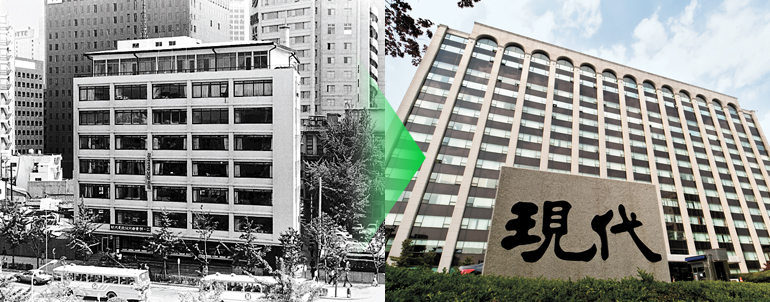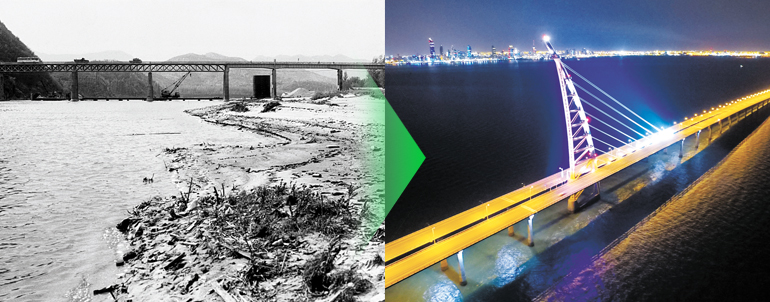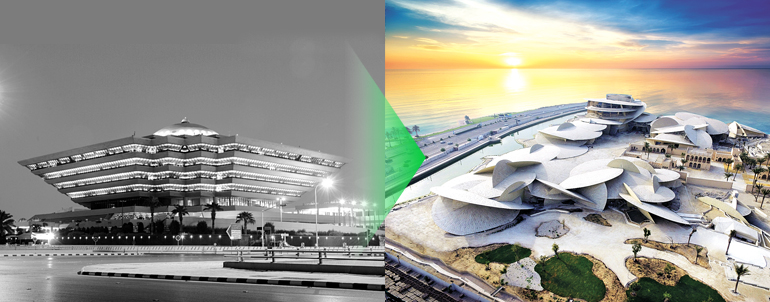
Latest News
- Hyundai E&C Signs PPA for Solar Renewables with Glennmont D&D Solar Holdings
- Hyundai E&C to Embark on UK SMR Project forging Korea-US-UK Technology Alliance
- Hyundai E&C Consolidates Leading Position in Concrete Safety and Quality Technology
- Hyundai E&C Selected as Preferred Bidder for Large Nuclear Power Plant in Bulgaria
- Hyundai E&C Attains “Leadership A” in CDP's Climate Change Assessment
Hyundai E&C marks its 74th anniversary: 1947 vs. 2021
A sign of “Hyundai Civil Works Co.,” known as Hyundai Togun, was put up first on the building of Hyundai Auto Service located in Cho-dong, Seoul, on May 25, 1947. After a merger with Hyundai Auto Service in 1950, Hyundai E&C was launched under the name of Hyundai Engineering & Construction Co., LTD. After the establishment, Hyundai E&C took the initiative in rebuilding Korea by constructing roads and bridges in the war-torn nation. At a time when there were neither professionals nor proper equipment, only hard working in construction sites and ceaseless efforts for research improved the business capability of Hyundai E&C.
Over time, scars of the Korean War were healed up, and various construction projects were actively conducted to lay the foundation for economic development, which led to extending the scope of the builder’s business activities. Hyundai E&C expanded its businesses by making inroads into the overseas market. Its dedication to the successful completion of construction projects through sprit of taking on challenges and perseverance eventually served as a bigger chance for Hyundai E&C. It has been fully committed to construction, while attempting to achieve a breakthrough whenever it faced risks. And such longstanding commitment made what Hyundai E&C is today. Currently, the builder is leading the domestic construction industry and growing into a global top-tier company. Hyundai E&C is changing the life of people by creating masterpieces around the world.
Head office: Mugyo-dong vs. Gye-dong

Hyundai E&C opened the so-called Mugyo-dong era with the opening of its own first company building in January 1961. For 14 years after its establishment, Hyundai E&C moved from the Pyeonghwa Sinmun Building in Gwanghwamun to the Samhwa Building in Sogong-dong, and finally settled down in no. 92, Mugyo-dong, Seoul. The head office in Mugyo-dong, considered one of the most modern high-rise buildings in the capital, symbolized the growth of Hyundai E&C. Its first company building was all the more meaningful in that it allowed the explosively growing company, which had started with only about 10 employees, to operate its businesses in a more active way. After that, Hyundai E&C moved the head office to Sejong-ro in 1976 and then Gye-dong in 1983 to accommodate the ever-growing size of its organizations and businesses. This laid the groundwork for Korea’s primary builder to actively enter the construction markets at home and abroad and build a solid business foundation. The opening of the “new era of the Gye-dong head office” in 2014 served as an opportunity to transform Hyundai E&C’s offices into a bright and pleasant workplace. Hyundai E&C supports its employees in working in a more convenient and efficient way by providing spaces which can meet varying purposes including meetings and relaxation.
Goryeong Bridge in Korea vs. Sheikh Jaber Causeway in Kuwait

A 36.1-kilometer new road opened over the sea in Kuwait in May 2020. Kuwait Sheikh Jaber Causeway is a cross-sea bridge constructed based on unrivaled technology of Hyundai E&C.
Hyundai E&C’s history of bridge construction traces back to the Korean War in 1950 when its experience in bridge construction was limited only to the restoration of small bridges without proper technology and equipment. In 1953, Hyundai E&C attempted to restore the Goryeong Bridge, resulting in huge losses which almost put the builder in danger of going bankruptcy. However, trust and knowhow accumulated through the bridge construction became one of the utmost assets of Hyundai E&C. After that, the builder enhanced its technological capability by developing construction equipment and dealing with a wide range of issues taking place in construction sites. Starting with the restoration of the Hangang Bridge in 1958, Hyundai E&C built a total of 13 bridges across the Han River flowing through the heart of Seoul. The more bridges Hyundai E&C built, the faster its technology advanced. Hyundai E&C constructed a number of bridges at home and abroad as a new road, such as the Namhae Bridge (the Korea’s first suspension bridge), the Jindo Bridge (the country’s first cable-stayed bridge), the Ulsan Bridge, (a masterpiece of suspension bridge construction), and the tentatively named Godeok Bridge (the concrete cable-stayed bridge with the world’s longest span) in the domestic market, along with the Hurricane Gulch Bridge crossing the canyon of the highest mountain peak in North America, Malaysia’s Penang Bridge (the world’s longest bridge of that time), and Turkey’s Third Bosphorus Bridge (the world’s first suspension-cable-stayed bridge) in the overseas marke.
Mapo Apartment vs. Hillstate and THE H
.jpg)
The emergence of Apgujeongdong Hyundai Apartment in 1975 transformed the area into an upscale residential complex. Starting with the construction of Korea’s first apartment complex, Mapo Apartment, in 1964, Hyundai E&C took the lead in the country’s residential culture by building Hilltop Apartment, Yeouido Sibeom Apartment, together with Apgujeongdong Hyundai Apartment.
Since the opening of the so-called apartment era in Korea, “Hyundai” has maintained its reputation of the country’s representative apartment brand. At a time when rapid industrialization increased population density of big cities in the country, Hyundai E&C supplied large-scale apartment complexes, contributing to resolving the problem with a shortage of houses. Its apartment brands, Hyundai Hometown and Hyundai Hyperion, reflected the concept of residence in response to changes of the times. Hyundai E&C has suggested new standards for residential environments by launching new premium residential brands such as Hillstate (2006) and THE H (2015), based on its long history and tradition of apartment construction.
Apartments bear significance as a place for increasing value of life, not simply a place for living. Hyundai E&C strives to improve standards for residential culture in Korea by combining its knowhow and cutting-edge technologies.
Gyeongbu Expressway in Korea vs. Lusail Expressway in Qatar

Hyundai E&C received an order to build a road for military operations from the US Army during the Korean War, which was the beginning of Hyundai E&C’s history of road construction. After the war, Hyundai E&C jumped into road pavement projects. Armed with the increased competitiveness, the builder won the bid for the Pattani-Narathiwat Expressway project in Thailand in 1965. Hyundai E&C enhanced its technological capability by conducting its first overseas project and applied such experience to the construction of the Gyeongbu Expressway connecting Seoul and Busan. Beginning with the construction of this main artery of the country, Hyundai E&C has been building arteries, big and small, in many countries.
Currently, “smart technologies” including the ITS (Intelligent Transport and System) are introduced to the construction and operation of roads. For example, the Changwon-Busan Road provides the system aimed at preventing secondary accidents from taking place in tunnels, and the Second Yeongdong Expressway offers the system enabling drivers to forecast road surface conditions, all of which provide a safer and more convenient traffic environment for drivers. Hyundai E&C is working on building a “road for the future” around the globe by applying ITS-related technologies to overseas expressway projects.
Building of the Ministry of Interior of Saudi Arabia vs. National Museum of Qatar

Starting with the Pattani-Narathiwat Expressway project in Thailand, Hyundai E&C entered the global construction market and constructed landmark buildings around the world. Among them, the building of the Ministry of Interior of Saudi Arabia has been considered one of the most famous works of Hyundai E&C since the completion of the construction in 1992. When the builder tapped into the overseas construction market, only a few its employees could analyze specifications. Nonetheless, Hyundai E&C successfully completed the construction of the overturned-pyramid-shaped building with a dome on the top, which required precise structural calculations and advanced construction technologies.
After constructing historic buildings such as Suntec City in Singapore and Bitexco Financial Tower in Vietnam, Hyundai E&C built the National Museum of Qatar in 2019 by introducing the three dimensional BIM system to the entire construction process, the first of its kind in the world. Hyundai E&C is taking the lead in the so-called K-Construction by building landmarks around the globe based on technological prowess and extensive experience.
Incheon thermoelectric power plant in Korea vs. Punta del Tigre combined-cycle power plant in Uruguay
.jpg)
Korea focused on expansion of electric power grids after the Korean Armistice Agreement in 1953. Power generation plants were needed the most for economic development of the country at a time when rural areas were lighted by lanterns and there were no factories run by electricity. At that time, power plant construction was led by foreign companies since Korean builders had no technologies to build power plants. After enhancing its technological capability at a rapid pace, Hyundai E&C completed the construction of Incheon thermoelectric power plant (units one to four). Hyundai E&C was in charge of procurement, construction and commissioning, with the exception of designing, which made the project an indicator of Hyundai E&C’s technological independence regarding power plant construction. Later, in the construction of Pyeongtaek thermal power plant (units one and two), Hyundai E&C was responsible for the entire project process including designing. It made efforts to enhance its technology on a constant basis by building the Al Mussaib power plant in Iraq and the Bundang combined cycle power plant in Korea. Its extensive experience in building a wide range of power plants, including thermoelectric power plants, combined cycle power plants and geothermal power plants, leads to lighting a wider world. Hyundai E&C is expanding its business scope in South America by successfully completing the construction of the Punta del Tigre combined-cycle power plant in Uruguay.
Past vs. present

Hyundai E&C, which started with only about 10 employees, went through an explosive growth. Hyundai E&C established the five-department system consisting of the general affairs department, the accounting department, the administration department, the materials department and the technology department at the end of the 1950s, and overhauled its organizations depending on company expansion. In 1958, it recruited college graduates, the first of its kind in the domestic construction industry, in the aim to strengthen corporate capabilities. One of the most noticeable changes through time are attire of employees and atmosphere of workplace. Almost all male employees wore a business suit with a white dress shirt and a necktie, and female employees put on a uniform until the 1990s. They worked with pens and piles of documents, instead of using computers. Having a good handwriting was considered the capability of the employees when they had to write business reports and draw floor plans by hand. Innovation is currently a key word. Hyundai E&C is doing the best to create a flexible corporate culture by allowing its employees to wear business casual outfits.
Even when there were not many telephones, Hyundai E&C had a channel for communication among its employees: The Hyundai, led by then vice president Chung In-young, was first published in 1951. Scripts were written by hand and mimeographed. Because a lot of efforts were made to publish only one copy, the corporate magazine repeated its publication and discontinuation. Hyundai E&C was published in a tabloid format in 1979, which was the root of the current corporate newspaper Hyundai E&C Today. The corporate newspapers have helped build a sense of fellowship among the employees by featuring a variety of issues regarding stories of employees and their families and key construction trends. Currently, online platforms, such as Newsroom, a blog, SNS and YouTube channel, play an important role in communication of Hyundai E&C. Notably, various online contents, including a Hyundai E&C web drama released on YouTube and a music video created in collaboration with rapper Kisum, show pleasant and lively aspects of Korea’s foremost builder. Hyundai E&C will provide more useful and friendly contents for customers through various platforms.

